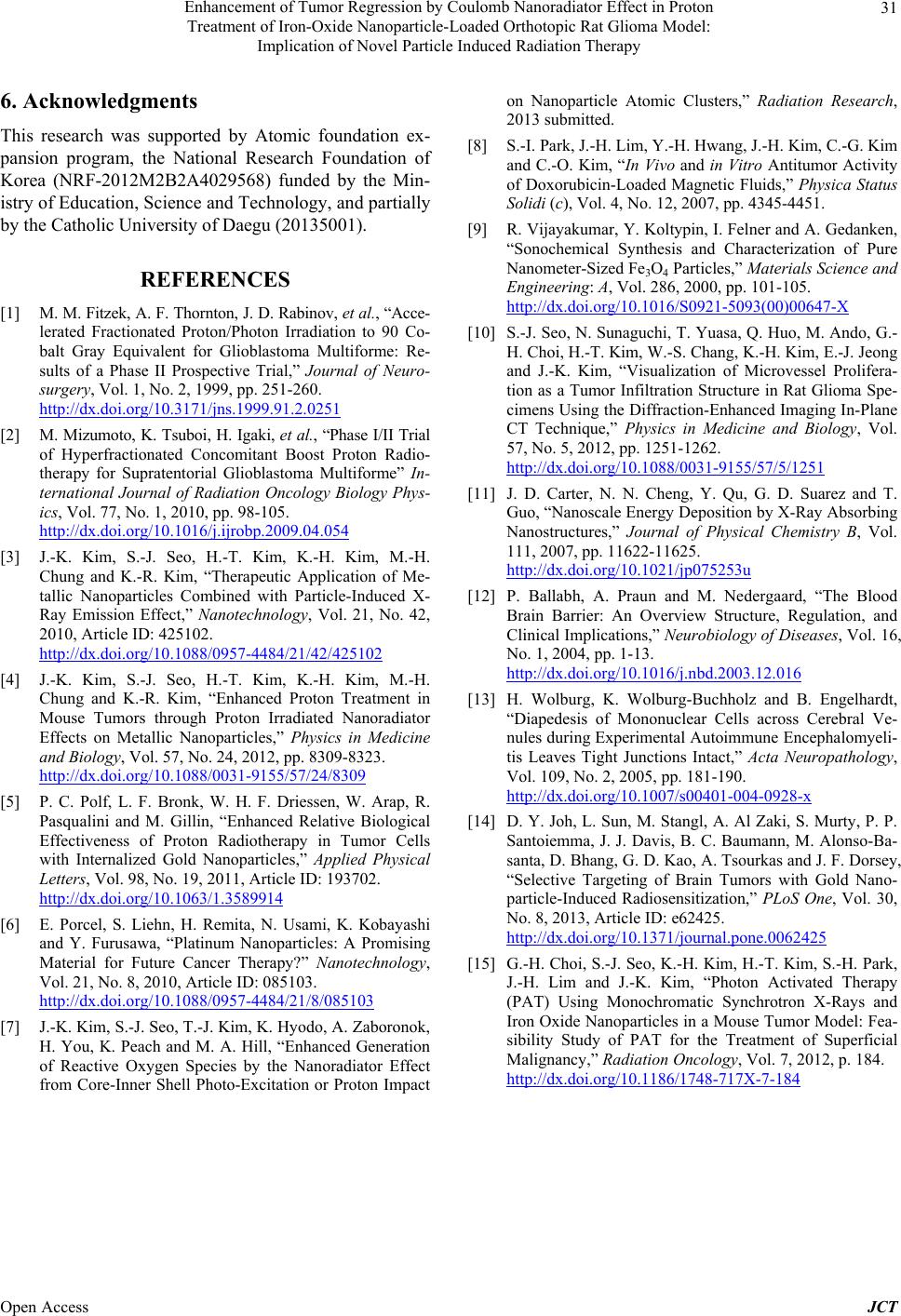
Enhancement of Tumor Regression by Coulomb Nanoradiator Effect in Proton
Treatment of Iron-Oxide Nanoparticle-Loaded Orthotopic Rat Glioma Model:
31
Implication of Novel Particle Induced Radiation Therapy
6. Acknowledgments
This research was supported by Atomic foundation ex-
pansion program, the National Research Foundation of
Korea (NRF-2012M2B2A4029568) funded by the Min-
istry of Education, Science and Technology, and partially
by the Catholic University of Daegu (20135001).
REFERENCES
[1] M. M. Fitzek, A. F. Thornton, J. D. Rabinov, et al., “Acce-
lerated Fractionated Proton/Photon Irradiation to 90 Co-
balt Gray Equivalent for Glioblastoma Multiforme: Re-
sults of a Phase II Prospective Trial,” Journal of Neuro-
surgery, Vol. 1, No. 2, 1999, pp. 251-260.
http://dx.doi.org/10.3171/jns.1999.91.2.0251
[2] M. Mizumoto, K. Tsuboi, H. Igaki, et al., “Phase I/II Trial
of Hyperfractionated Concomitant Boost Proton Radio-
therapy for Supratentorial Glioblastoma Multiforme” In-
ternational Journal of Radiation Oncology Biology Phys-
ics, Vol. 77, No. 1, 2010, pp. 98-105.
http://dx.doi.org/10.1016/j.ijrobp.2009.04.054
[3] J.-K. Kim, S.-J. Seo, H.-T. Kim, K.-H. Kim, M.-H.
Chung and K.-R. Kim, “Therapeutic Application of Me-
tallic Nanoparticles Combined with Particle-Induced X-
Ray Emission Effect,” Nanotechnology, Vol. 21, No. 42,
2010, Article ID: 425102.
http://dx.doi.org/10.1088/0957-4484/21/42/425102
[4] J.-K. Kim, S.-J. Seo, H.-T. Kim, K.-H. Kim, M.-H.
Chung and K.-R. Kim, “Enhanced Proton Treatment in
Mouse Tumors through Proton Irradiated Nanoradiator
Effects on Metallic Nanoparticles,” Physics in Medicine
and Biology, Vol. 57, No. 24, 2012, pp. 8309-8323.
http://dx.doi.org/10.1088/0031-9155/57/24/8309
[5] P. C. Polf, L. F. Bronk, W. H. F. Driessen, W. Arap, R.
Pasqualini and M. Gillin, “Enhanced Relative Biological
Effectiveness of Proton Radiotherapy in Tumor Cells
with Internalized Gold Nanoparticles,” Applied Physical
Letters, Vol. 98, No. 19, 2011, Article ID: 193702.
http://dx.doi.org/10.1063/1.3589914
[6] E. Porcel, S. Liehn, H. Remita, N. Usami, K. Kobayashi
and Y. Furusawa, “Platinum Nanoparticles: A Promising
Material for Future Cancer Therapy?” Nanotechnology,
Vol. 21, No. 8, 2010, Article ID: 085103.
http://dx.doi.org/10.1088/0957-4484/21/8/085103
[7] J.-K. Kim, S.-J. Seo, T.-J. Kim, K. Hyodo, A. Zaboronok,
H. You, K. Peach and M. A. Hill, “Enhanced Generation
of Reactive Oxygen Species by the Nanoradiator Effect
from Core-Inner Shell Photo-Excitation or Proton Impact
on Nanoparticle Atomic Clusters,” Radiation Research,
2013 submitted.
[8] S.-I. Park, J.-H. Lim, Y.-H. Hwang, J.-H. Kim, C.-G. Kim
and C.-O. Kim, “In Vivo and in Vitro Antitumor Activity
of Doxorubicin-Loaded Magnetic Fluids,” Physica Status
Solidi (c), Vol. 4, No. 12, 2007, pp. 4345-4451.
[9] R. Vijayakumar, Y. Koltypin, I. Felner and A. Gedanken,
“Sonochemical Synthesis and Characterization of Pure
Nanometer-Sized Fe3O4 Particles,” Materials Science and
Engineering: A, Vol. 286, 2000, pp. 101-105.
http://dx.doi.org/10.1016/S0921-5093(00)00647-X
[10] S.-J. Seo, N. Sunaguchi, T. Yuasa, Q. Huo, M. Ando, G.-
H. Choi, H.-T. Kim, W.-S. Chang, K.-H. Kim, E.-J. Jeong
and J.-K. Kim, “Visualization of Microvessel Prolifera-
tion as a Tumor Infiltration Structure in Rat Glioma Spe-
cimens Using the Diffraction-Enhanced Imaging In-Plane
CT Technique,” Physics in Medicine and Biology, Vol.
57, No. 5, 2012, pp. 1251-1262.
http://dx.doi.org/10.1088/0031-9155/57/5/1251
[11] J. D. Carter, N. N. Cheng, Y. Qu, G. D. Suarez and T.
Guo, “Nanoscale Energy Deposition by X-Ray Absorbing
Nanostructures,” Journal of Physical Chemistry B, Vol.
111, 2007, pp. 11622-11625.
http://dx.doi.org/10.1021/jp075253u
[12] P. Ballabh, A. Praun and M. Nedergaard, “The Blood
Brain Barrier: An Overview Structure, Regulation, and
Clinical Implications,” Neurobiology of Diseases, Vol. 16,
No. 1, 2004, pp. 1-13.
http://dx.doi.org/10.1016/j.nbd.2003.12.016
[13] H. Wolburg, K. Wolburg-Buchholz and B. Engelhardt,
“Diapedesis of Mononuclear Cells across Cerebral Ve-
nules during Experimental Autoimmune Encephalomyeli-
tis Leaves Tight Junctions Intact,” Acta Neuropathology,
Vol. 109, No. 2, 2005, pp. 181-190.
http://dx.doi.org/10.1007/s00401-004-0928-x
[14] D. Y. Joh, L. Sun, M. Stangl, A. Al Zaki, S. Murty, P. P.
Santoiemma, J. J. Davis, B. C. Baumann, M. Alonso-Ba-
santa, D. Bhang, G. D. Kao, A. Tsourkas and J. F. Dorsey,
“Selective Targeting of Brain Tumors with Gold Nano-
particle-Induced Radiosensitization,” PLoS One, Vol. 30,
No. 8, 2013, Article ID: e62425.
http://dx.doi.org/10.1371/journal.pone.0062425
[15] G.-H. Choi, S.-J. Seo, K.-H. Kim, H.-T. Kim, S.-H. Park,
J.-H. Lim and J.-K. Kim, “Photon Activated Therapy
(PAT) Using Monochromatic Synchrotron X-Rays and
Iron Oxide Nanoparticles in a Mouse Tumor Model: Fea-
sibility Study of PAT for the Treatment of Superficial
Malignancy,” Radiation Oncology, Vol. 7, 2012, p. 184.
http://dx.doi.org/10.1186/1748-717X-7-184
Open Access JCT